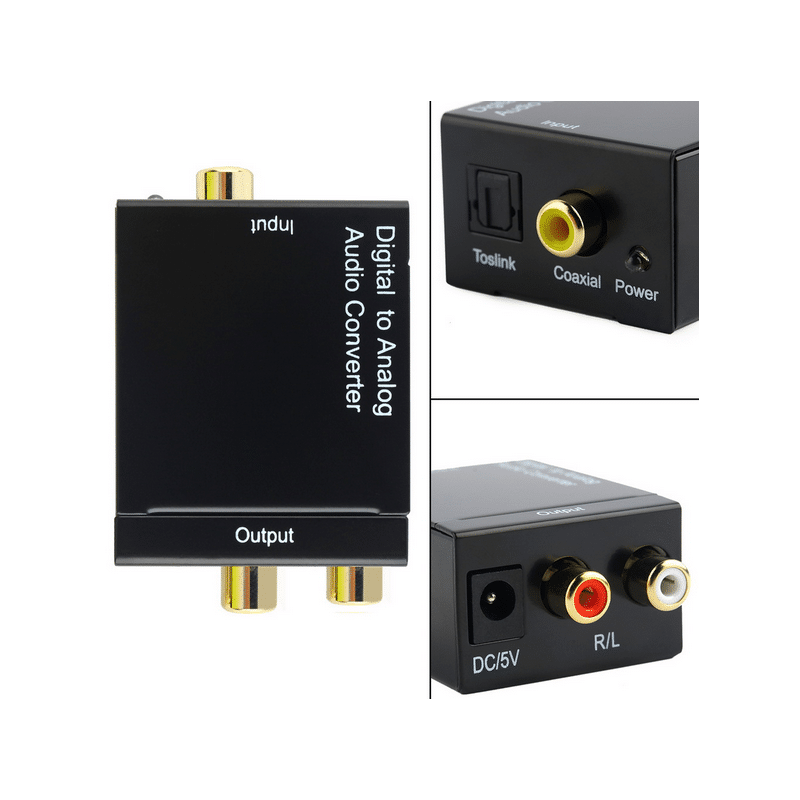


The idea was to make sure few people are left behind, but their efforts caused some confusion. The original date for the analog-to-digital transition had to be moved because the FCC needed to raise awareness of the change among the population. The remaining portion of the broadcast signal will be available to consumers for wireless services.
#Digital to analog converter box free
One reason for the switch was to free up space for police, fire and other public safety communications. The reason? Broadcasters moved their signals to another part of the radio spectrum. Regular broadcasters in the United States have completed the transition to digital television (DTV). 17, 2009, some analog channels in the United States went dark - with a few exceptions, the rest did so on June 12. If you live in an area near a broadcast station, you can still plug a pair of rabbit ears into the antenna jack on the back of your set and get programming. But in general, you don't have to have all those things to watch TV.
#Digital to analog converter box tv
Unfortunately, his color-broadcasting standard wasn't compatible with existing TV sets, and in 1953, the National Television Standards Committee (NTSC) adopted RCA's method of color broadcasting instead.įrom there, we have incremental introductions - the remote control, cable and satellite providers, and videocassette recorders ( VCRs), et cetera. Ĭolor TV was around as early as 1946, when CBS engineer Peter Goldmark - who also had a hand in creating the long-playing vinyl record - developed a method of broadcasting in color. And by 1960, there were 515 commercial stations, with TVs in 85 percent of American homes. In 1945, there were only nine commercial TV stations broadcasting, but by 1949, there were 48. Though there were regular broadcasts, people at large didn't adopt television until after World War II. Early television began in the 1870s, but TV didn't really catch on until the introduction of electronic television in the early 20th century. I'd really love to not give up on it just yet.As important as television is to many people in the United States, the technology behind the medium hasn't changed that much since its introduction. Trust me on this.)ĭo you have any suggestions as to what could be the problem? Any other ideas regarding the troubleshooting? I do not see any obvious other bulgy things on the board (and that was all I knew to look for!). I re-soldered my connections just in case but I still get the "no signal" error (despite my antenna etc. Obviously, I have quadruple checked the connections and I know they are fine since I can watch all the channels I want using my other unit. Please check antenna and connections." and I get no image or sound. Specifically, it will power up and display the onscreen information (like which channel, volume etc.) but all channels (with THIS UNIT ONLY) give the error "No signal. They told me I can go "higher" in the V but not lower.)Īfter replacing the two capacitors, the unit powers on but it does not work. (I will note, in case it is important, that the originals were 470uf/10v but the store only had 470uf/16v ones - which I was told would be fine. When I opened this box (feeling brave having replaced a popped cap in the power supply), I saw two bulging capacitors so I replaced them. I doubted my repair of the power supply but it worked completely fine on the other unit. Initially (after my capacitor change), using either power supply, the unit flicked on and off and never got to showing a station. Remember that the Converter box itself HAD been working (when I powered it using the other unit's power supply) but now it is not working. However I seem to have a new problem which confuses me greatly. Long story short, I replaced a blown capacitor in the power supply and it is now working! That is to say, both of my power supplies will power one of my units and that unit works just fine no matter which supply I use. Using the other power supply, the 'not working" unit would work and, conversely, my second unit would cease to work when plugged in to the questionable power supply). Because I have the other unit and the other power supply I was completely confident that the problem was with the power supply. Initially, one of the units was having intermittent power problems and finally just quit and would not power up. This has been helpful in the troubleshooting of my current problem. I have two identical Access HD DTA1030 converter boxes for my OTA TV viewing.


 0 kommentar(er)
0 kommentar(er)
